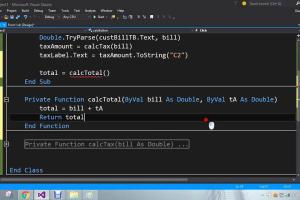Mastering Function Calls in VB & VBA: Comprehensive Guide with Syntax & Examples

-
Quick Links:
- Introduction
- Understanding Functions
- Syntax for Calling Functions
- Examples of Calling Functions
- Case Studies
- Step-by-Step Guide
- Expert Insights
- Common Mistakes to Avoid
- FAQs
Introduction
Visual Basic (VB) and Visual Basic for Applications (VBA) are powerful tools used by developers and power users alike to automate tasks and enhance productivity in applications like Microsoft Office. This article aims to provide a comprehensive understanding of calling functions in VB and VBA, covering everything from syntax to practical examples, case studies, and expert insights.
Understanding Functions
Functions in programming are blocks of code that perform a specific task. They help in organizing code, reducing redundancy, and making it easier to maintain. In VB and VBA, functions can return values and accept parameters, making them versatile tools for developers.
Types of Functions
- Built-in Functions: Functions that are pre-defined in the language.
- User-defined Functions: Functions created by the programmer to perform specific tasks.
Syntax for Calling Functions
Understanding the syntax for calling functions is crucial for effective programming in VB and VBA. Below is the general syntax for a function call:
FunctionName(Parameter1, Parameter2, ...)
Defining Functions
Before calling a function, it must be defined correctly. Here's the syntax for defining a function:
Function FunctionName(Parameter1 As DataType, Parameter2 As DataType) As ReturnType
' Code to execute
End Function
Examples of Calling Functions
Example 1: Simple Function Call
Function AddNumbers(a As Integer, b As Integer) As Integer
AddNumbers = a + b
End Function
Sub TestAdd()
Dim result As Integer
result = AddNumbers(5, 10)
MsgBox result ' Displays 15
End Sub
Example 2: Function with Optional Parameters
Function Greet(Optional name As String = "World") As String
Greet = "Hello, " & name
End Function
Sub TestGreet()
MsgBox Greet() ' Displays "Hello, World"
MsgBox Greet("Alice") ' Displays "Hello, Alice"
End Sub
Case Studies
Let's explore a few case studies where calling functions in VB and VBA has significantly improved productivity:
Case Study 1: Automating Reports in Excel
A financial analyst created a series of user-defined functions in VBA to automate the generation of monthly reports. By calling these functions, they could pull data from various sheets, perform calculations, and generate summaries with minimal manual intervention, saving hours of work.
Case Study 2: Data Validation in Forms
A developer used functions to validate user input in a form created in Access. By calling validation functions before saving data, the developer ensured that data integrity was maintained, reducing errors and improving the reliability of the application.
Step-by-Step Guide
Creating and Calling Your First Function
- Open your VB or VBA editor.
- Create a new module.
- Define your function using the syntax provided.
- Test the function by calling it from a subroutine.
- Debug and iterate as necessary.
Expert Insights
According to industry experts, mastering function calls in VB and VBA can significantly enhance your programming skills and productivity. Functions allow for better code organization and reuse, making it easier to manage larger projects.
Common Mistakes to Avoid
- Not returning a value from the function when it is expected.
- Forgetting to declare parameters correctly.
- Overcomplicating functions with too many responsibilities.
FAQs
Q1: What is the difference between a Sub and a Function in VBA?
A Sub performs actions but does not return a value, while a Function can return a value.
Q2: Can I call a function in a different module?
Yes, you can call a function from another module as long as it is declared as Public.
Q3: What data types can be used as function parameters?
Common data types include Integer, String, Double, Boolean, etc.
Q4: Can functions have default values for parameters?
Yes, functions can have optional parameters with default values.
Q5: How do I handle errors in functions?
You can use error handling mechanisms such as On Error GoTo to manage errors in functions.
Q6: Is it possible to call a function recursively?
Yes, functions can call themselves recursively, but it should be done with caution to avoid infinite loops.
Q7: What is the scope of a function in VBA?
The scope depends on how the function is declared: Public, Private, or Friend.
Q8: Can functions be passed as parameters to other functions?
Yes, you can pass functions as parameters using the AddressOf operator.
Q9: How do I return multiple values from a function?
You can return multiple values by using a Type or by using an array.
Q10: What are some best practices for writing functions in VBA?
Keep functions focused, use descriptive names, and document your code.
Random Reads
- Easy ways to reset and restore ipod
- How to change mac address on android
- How to change icon windows 7
- How to set up your playstation 1
- How to install artificial turf
- How to install bathroom exhaust fan
- Mastering fatalities mortal kombat x
- Mastering fatalities mortal kombat karnage
- How to connect ps4 controller to steam
- Enable browser cookies ipad